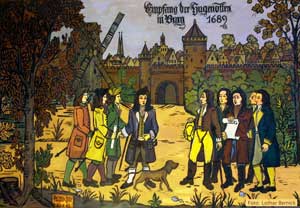A large column of more than 1000 people from the Mannheim congregation arrived in Magdeburg in 1689, after Mannheim had been destroyed by French troops. The French Reformers had already been living in Mannheim since 1568. They were resettled mainly in the newer parts of Magdeburg.
Because the city of Burg had become part of Brandenburg in 1688, the initial refugees were also able to immigrate here. The first Huguenot came from Magdeburg. His name was Pierre Arnac, as was his son's. At the same time 206 Waldensers came from Stendal. They originated from Piemont in Savoyen. Back then the Waldensers were a pre-reformist layperson movement originating from the Lyon merchant Petrus Valdes.

The Huguenots are welcomed in Burg in 1689
Huguenot families started to arrive in Burg in 1689. By 1704 the French congregation had increased to 53 families with 172 people. Among them were the families Delorme (1690) and Paté (1692) whose descendants are still established in Burg today.
After the Thirty Years' War (1648) the Upper Palatinate (Oberpfalz region in southwest Germany) was allocated to the catholic Bavaria. The resident population was afraid that their homeland would become catholic. Large parts of Palatinate, especially areas west of the Rhine River as well as the cities of Heidelberg and Mannheim were scenes of rage and havoc when French troops moved against Reformed citizens. As a result these people left their homeland. Natives from Palatinate as well as other members of the Reformed Church from Swabia and Switzerland immigrated.
Next: Where did they come from? What were their names?
Previous: The Edict of Potsdam